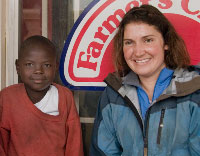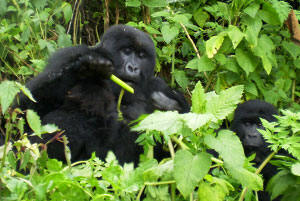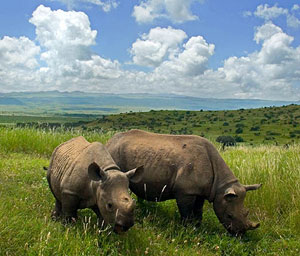|
|
|
Trip to Uganda, Rwanda and Kenya –
January 2007 |
 |
This year’s trip was amazing and life
changing as usual, filled with amazing
animals and unforgettable people. We saw
everything from refugee camps in Uganda to
wealthy people trying to make a difference
in these fantastic countries.
|
|
Both Uganda
and Rwanda were very safe. We could walk
around with no problems in every city we
went to. In Kabale, Uganda, I bought some
peas from a little girl as a way to give
something to her. I decided to leave them
because they needed them more then I did and
they ran after our tour guide to make sure I
got them back. The peas traveled all the way
to Rwanda where we gave them along with any
other leftover food to our gorilla guide,
Francis. The night before our trek to see
the gorillas he told us about the genocide
and how in only 12 years the people in
Rwanda have come such a long way. They have
developed their own courts to bring people
to justice which may mean building a house
or buying a cow and then allowing everyone
to forgive each other and move forward. They
are all Rwandans now. They have signs
everywhere about the genocide so they never
will forget and will continue to grow as a
country. I was amazed by the strength to
heal. |
|
 |
|
The gorillas
were fantastic. We were in the same area
where Dian Fossey did her research. There
are ten habituated troops of gorillas and
seven are used for tourism. Eight people go
up at a time for only an hour a day once a
day. This minimizes the stress on the troop.
I was grabbed by one of them, four of us
were. It was a strong gentle touch that is
hard to explain and even harder to forget.
We were very close to babies and the silver
back named Ubumwa which means unity in
Rwandan. Our troop name was Amahora which
means peace. They were an easy troop to
habituate. Seeing them up there on the most
beautiful mountain, comfortable in their
surroundings brought tears to our eyes. They
are true perfection and the picture of
peace. Their population has increased 15% in
the last couple years so they are up to 700.
I strongly recommend a trip to see them. For
more information or how to help the animals
or orphans, please contact me.
We were off
to Lewa in Kenya next. I got to see all the
people I know there and all the animals too.
I massaged and rode the young horses I have
known since they were born. I did a
follow-up massage class for the syce
(grooms). I also was able to see Tula who is
a female black rhino that I worked on when
she was six months old. She is too big for
that now but it was great to see her and her
half brother that I did get to give a
scratch to. The sanctuary has done a
remarkable job increasing the black rhino
population. |
|
 |
|
I also saw
the three cheetah boys eating an ostrich. I
have known them since they were born. Lions,
zebra, and everything else that is Africa
graced my camera lens in my favorite place,
Lewa. They
are helping to support an AIDs orphanage in
the area. I met Sarah there who was left to
die as a baby because her mother had died of
aids and she has the virus. The women who
run the center went and got her out and now
she is a bright outgoing 4 year old with a
great smile. We saw the lack of enough food
and medicine but we also saw how far along
they have come. On the way out we met Irene.
She was raped 5 years ago by Somali shifters
and so were her daughter and son. They have
both died of aids and she has very little
time left. Kadija and the center give her
her only comfort.
Things
like this are hard to see but they along
with all the beauty are what make Africa
special. These people keep going and are
grateful for each day whether they are an
orphan, dying or helping those who are.
Their strength is like that of the amazing
animals that surround them. Tourism saves
the people who learn to save the animals. I
only worked five days this trip and as usual
I learned more than I left. If you would
like any information on how to help or how
to book a trip over, please let me know.
Hope you
enjoy the trip summary!
Maria
(Back to
top) |
|
|
|